Remember Rita Senger, who illustrated the winning cover in the 1915/1920 Magazine Cover Smackdown? “Next time I write about illustrators I love, I’m going to write about Senger,” I promised.
And I tried! As I prepared for my Thanksgiving post on 1920 women illustrators I’m thankful for, I scoured the internet for illustrations by, and information about, Senger.
And came up with…almost nothing. Just a handful of magazine covers, most of which I’d already seen, the last one this August 1919 Vanity Fair cover.
What happened? None of the usual suspects, like findagrave.com and Wikipedia, yielded anything. Then I came across a blog post by a quilter named Lori Kennedy saying that fellow quilter Patty Stein was Rita Senger’s granddaughter. The post included one of Senger’s Vogue covers and some photographs of her and her family.
Armed with the last name Stein, I found a listing for a Mrs. Rita Senger Stein of Highland Park, Illinois, among the life members of the Art Institute of Chicago in its 1925 annual report. That was it.

If I wanted to find out more about Rita Senger, I realized, I was going to have to do something almost without precedent for this blog: contact an actual living person.*
So, one evening back in November,** I sent a message to Lori Kennedy asking if she could put me in touch with Patty Stein. By the time I woke up the next morning, there was an e-mail from Patty.
Patty turned out to be a delightful person, and we talked on the phone for almost an hour. She was making a cake as we talked, which I found extremely impressive, since I consider myself a decent baker but I can’t even focus if there’s music on in the background.
This is Rita’s story, mostly as I heard it from Patty but incorporating some of my own research as well. Patty emphasized that she was only sharing the impressions of a granddaughter, which may not be entirely accurate. (The chronology of Senger’s magazine covers—and any possible inaccuracy in this respect—is mine.)
Rita Senger was born in New York City in 1893, the daughter of Adolph and Barbara (Ehrlich) Senger. (The name was sometimes spelled “Sanger.”) She was an art prodigy as a child, and she went to art school at the age of sixteen or seventeen.
Rita’s father moved to Arizona after becoming ill with asthma, leaving Rita to care for her mother, three sisters, and two brothers (both of whom went on to become architects). Success as an illustrator came early. Her first Vogue cover appeared in June 1915,
and her first Vanity Fair cover—the one that won my magazine cover contest—followed three months later.
Senger illustrated one cover for each magazine in 1916,
two Vogue covers in 1917,***
one Vanity Fair cover in 1918,
and the August 1919 Vanity Fair cover, the last in her career.
Patty is not sure how Rita met her husband, Joseph Stein. It was an unusual match for the time; he was Jewish and Rita, who came from a non-religious family, was not. Stein’s grandfather was one of the first Reform rabbis in Chicago, but he himself was not a practicing Jew. He was a wealthy businessman, the owner of Lucien Lelong, Inc., the U.S. affiliate of the Paris-based Société des Parfums Lucien Lelong. (The two companies were sold to Coty in 1953.)
These drawings of Lucien Lelong’s Paris office appear on a blog about the company’s history. The magazine and date are unidentified, but they look like ca. 1920s Vanity Fair to me.****

Joseph had a keen artistic sense himself, and he paid a great deal of attention to the appearance of his products. Here is his patent for a Lucien Lelong perfume bottle:
When Rita and Joseph married, she joined him in Chicago. The couple later settled in the suburb of Highland Park. Their son Tom, their only child, was born in 1920.
When I saw a picture of Rita with her extended family on Lori Kennedy’s website, I hoped that, having given up her career, she had gained a fulfilling life of a different sort. Life is rarely so simple, unfortunately. Like many parents of their time and class, she and her husband sent Tom to boarding school from an early age. Living outside of the hustle and bustle of the city, she felt isolated. “I believe she was a very frustrated artist and wife,” Patty said.
Rita did appreciate the benefits of wealth, though. In addition to their home in Highland Park, she and her husband owned, over the course of their marriage, an apartment on the Champs-Élysées and houses in Maine and in the Long Island town of Oyster Bay.
Patty remembers Rita, whom her grandchildren called Tita after a mispronunciation by one of the children, as a tiny woman with a mink collar, pearls, and diamonds. She smoked at a time when that was the mark of a sophisticated woman. “They had an African-American cook who was always baking stuff—it was out of Gone With the Wind,” Patty told me. “I never remember her eating anything except pound cake and butter.”
After her marriage, Rita expressed her artistic side through patronage of the arts. In addition to her association with the Art Institute of Chicago, she was a collector, purchasing works by modern artists including the sculptors Kenneth Armitage and Henry Bertoia.
When their son Tom grew up, he wanted his own family to be very different from the one he was raised in. He married Pauline Blume, the daughter of Ernest Blume, a Marshall Field’s home goods buyer. Ernest and Joseph had had a nodding acquaintance before the couple met. The two men, who shared an appreciation for aesthetics, saw each other occasionally at lunch at Marshall Field’s.
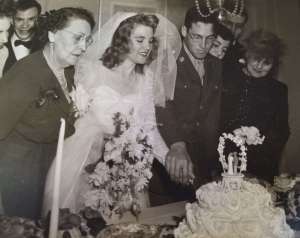
Rita Senger Stein, far right, at her son’s wedding reception, October 1943 (courtesy of Patty Stein)
Tom and Pauline eventually settled in Colorado with their five children, whom Patty, the youngest, describes as “boisterous, smart, and mouthy.” Their sophisticated grandmother, who thought children should be seen and not heard, didn’t know what to make of them. She enjoyed them one at a time, and developed a special bond with her oldest grandson, but “five was way too many,” Patty said. One time, when Patty was little, she drew paper dolls and showed them proudly to her grandmother. Rita pointed out that the figures were out of proportion.*****
Art was an important part of the family’s daily life. “I did not grow up with a mom who had crocheted doilies on the sofa,” Patty said. When the family went to an exhibition of Bertoia’s work, Patty’s sister was told to stop touching the tree sculptures. “My grandmother lets me,” she said.
“She had so much influence on us five and our extended family,” Patty said of her grandmother. One of Rita’s nephews went on to be an artist and designer. Patty herself went on to a different kind of artistic career, as a ballet dancer.
When Rita was 85 years old, she and her husband moved to Denver so Tom and his family could care for them. One day, Rita sat Patty down and pulled out a portfolio from the 1920s, with drawings of nudes in copper and black. Until then, Patty hadn’t known that Rita had continued drawing after her career ended. “She was so gifted,” Patty said, “to see curves and shadows and lines where none of the rest of us could.”
Rita died on December 30, 1990, at the age of 97. For her descendants, her art collection, her furniture, and her own art work serve as tangible reminders of her artistic sensibility and her talent. For the rest of us, her art lives on online. The Library of Congress, which has the original of the July 1916 Vanity Fair cover in its collection, featured it in a 2002 exhibition titled “American Beauties: Drawings from the Golden Age of Illustration.”
The website for the exhibition states that “Rita Senger’s lithe beauty dancing on a shore (ca. 1916) embodied a freedom based on insistent individuality. Compared with their predecessors, [fellow illustrator Ethel] Plummer’s and Senger’s figures move freely in more public, open spaces.”
If Rita had enjoyed that same freedom in her own life, the world would be the richer for it. Still, I feel lucky to have discovered the work she did leave us, and, through Patty, to have learned this remarkable woman’s story. I can think of no better way to celebrate Women’s History Month than telling it here.

*The “almost” being because in 2018 I called the Huntington Museum of Art in West Virginia and talked to a very nice woman who confirmed that the museum still owned the painting “Lead Kindly, Light,” by William Edouard Scott, which was featured on the cover of the April 1918 issue of The Crisis. Also, I e-mailed the Library of Congress in 2019 for a post that’s still on my to-do list. But contacting people whose job it is to answer your questions is very different from reaching out to a stranger and saying, “Tell me all about your grandma!”

**I know, not exactly lightning speed. In my (feeble) defense, I left Washington, D.C., where I’d unexpectedly spent almost a year, for Cape Town shortly after my conversation with Patty, and after that I had some time-specific posts to do for the holidays, Black History Month, etc. Still!
***Or possibly three. Vogue’s website identifies this September 15, 1917, cover as being Senger’s,

but credits the September 1 cover, which is definitely hers, to Alice De Warenn Little, so it’s possibly that they flipped the attributions. Vogue published two issues a month at that point, and I’ve never come across two covers by the same artist during the same month.
****The life of Lelong, who was also a prominent couturier, makes for fascinating reading. During his marriage (possibly of convenience) to Princess Natalia Pavlovna Paley, she had a messy entanglement with the writer Jean Cocteau, who was gay. Another one of Lelong’s wives later married Collette’s widower.

Lucien Lelong in 1925 (National Photo Company)
*****When Patty told me this, I laughed and told her about the time my brother and I, aged about eight and nine, were designing houses on graph paper. My father took a quick glance at our floor plans and told us the plumbing was misaligned—the second-floor bathroom needed to be directly above the first-floor bathroom so that the pipes would line up.





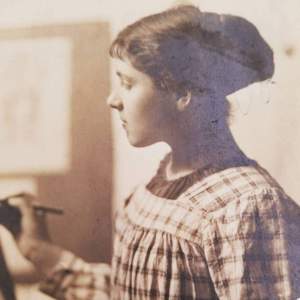

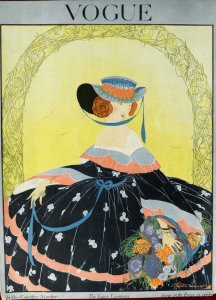
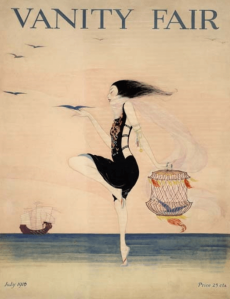



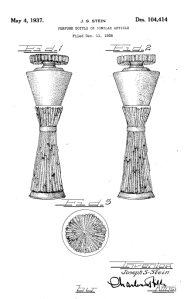



Wonderful detective work! And even at some remove, the grandmother had good observations.
I often think of how much I missed in not knowing to ask my grandmother and her sister about turn of the century Davenport Iowa, something of which I had no knowledge would be interesting when they were still alive and vital.
LikeLiked by 1 person
Thanks, Frank! I’ve always been interested in that time and place, due mostly, I confess, to “The Music Man.” During a cross-country drive in October (more about that in an upcoming post), my brother and I stayed overnight in Rock Island, Illinois, Davenport’s across-the-river neighbor. Due to a lack of urban development, it retains some of the area’s turn-of-the-last-century atmosphere.
I only knew one of my own grandparents, and I often wonder what they were all doing during the time I’m writing about. My father’s mother, for example, might have marched with the Bohemian women in New York’s 4th of July parade in 1918.
LikeLike
Mary Grace,
Fascinating research! My father, Dr. Robert Maidment was a professor at Northwestern University in the mid 1960’s. I always knew Rita as the sister of my maternal grandfather, Lester Sanger, a well known architect in NYC with a summer home in Sea Girt, NJ. My family would visit the Steins and I recall the artwork and spiral staircase in their home. In fact, there is a life-sized print hanging in my hallway, gifted to my father @1965. Apparently it did not fit with Rita’s decor! My mother, Joan Sanger, was a gifted pianist and her sister, Kathryn Sanger Hanley, was a professional ballet dancer in NYC.
LikeLike
Hi mary- fascinating article-
It appears i am am related to Patty and would like to know how to get hold of her- I am also an artist and a decsendent of Liebman Adler- as as she- I was researcing her great great grandma Bella- my gt grt aunt-
Cheers- Josie
LikeLiked by 1 person
That’s amazing, Josie! Could you send me your contact information on the Contact page?
LikeLike
Fascinating research Mary Grace! Rita was my great aunt, sister of my maternal grandfather Lester Sanger, a well known architect in NYC with a summer home he designed and built in Sea Girt, NJ. My mother, Joan Sanger Maidment was an accomplished pianist and her sister, Kathryn Sanger Hanley of Upper Montclair, NJ, was a professional ballet dancer in NYC. We visited the Steins during the mid-60’s at their home in Chicago. In fact, there is a large print hanging just outside my bedroom that Rita gifted to my father @1965. Aunt Rita apparently felt the nude print did not fit into her fabulous decor! My father always insisted the print was a Chagall original, but I have my doubts.
LikeLiked by 1 person
Jeff, it’s great to hear from you! It’s fascinating to hear about your, and Rita’s, talented extended family. Of all the posts I’ve written over the years, this is my favorite, and I’m glad you came across it.
LikeLike